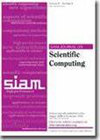The purpose of the SIAM Journal on Scientific Computing is to foster the advancement of computational techniques for the solution of large-scale problems arising in scientific computation. Apart from quality, the principal criterion for acceptance of a paper is its relevance to the development and implementation of the computational methods needed to solve such problems. Papers should be written so that they are accessible and of interest to a wide variety of readers in scientific computation and should address new computational algorithms and techniques. Papers describing novel computational solutions to problems motivated by statistical considerations and/or computational solutions to problems arising from experimental and observational data are encouraged. Papers of a theoretical nature are appropriate, provided that relevance to applications in science and engineering is demonstrated, and computational results illustrate the effectiveness of new algorithms. Papers on applications are desirable if their thrust is to illuminate the methods used or to develop new computational methods; papers should contain enough information about the application to orient other computational scientists but should avoid details of interest only to the applications specialist. Papers addressing high-performance aspects of scientific computation are particularly encouraged, provided they are numerically useful. However, papers that have a significant architectural content are acceptable only if they are clearly useful to the reader in developing new computational techniques or if they shed light on the scope and limitations of the theory involved. Papers describing mathematical software may be appropriate, but only if they introduce new algorithms or make substantial improvements in existing algorithms.
